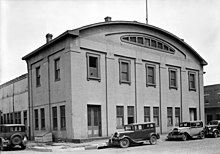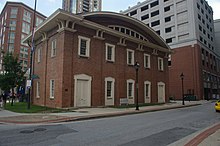President Street Station
President Street Station | |
Isaac Ridgeway Trimble; Philadelphia, Wilmington and Baltimore Railroad | |
| Architectural style | Mid 19th Century Revival, Italianate, Greek Revival |
|---|---|
| Restored | 1996-1997 |
| NRHP reference No. | 92001229[1] |
| Significant dates | |
| Added to NRHP | September 10, 1992 |
| Designated BCL | 2009 |
The President Street Station in Baltimore, Maryland, is a former train station and railroad terminal. Built in 1849 and opened in February 1850, the station saw some of the earliest bloodshed of the American Civil War (1861-1865), and was an important rail link during the conflict. It is the oldest surviving big-city railroad terminal in the United States.
In 1997, a preservation campaign and renovation project was completed, enabling the station to be operated as Baltimore Civil War Museum.
History
19th century

The
The B&PD exchanged freight cars with the
The B&PD and its merger successor company, the Philadelphia, Wilmington and Baltimore Railroad (PW&B), transferred passengers to the B&O's first downtown depot at East Pratt and South Charles streets by a horse-drawn car on B&O's connecting track. (The Baltimore City Council prohibited the operation of locomotives on this track for reasons of frightening horses and fears of fires).[2]: 32 By 1838, the PW&B was carrying passengers from further northeast through Philadelphia to Baltimore, where they could transfer to the B&O and continue west to Ohio or by a new branch line further south to the national capital at Washington, D.C.[5]
The PW&B started building its own station at the southwestern corner of President Street with Canton Avenue with train yards, including a roundhouse, shops and freight warehouses of about six square city blocks, extending east along Canton Avenue, later renamed Fleet Street.[6]: 3 The Greek Revival-style station opened on February 18, 1850.[7][8]
In addition to the brick head house with a distinctive arched roof, the original station also had a 208 feet (63 m) long barrel vaulted train shed over the tracks.[9] The PW&B added a similarly styled freight house, adjacent to the south of the passenger station, in 1852.[6][10]
American Civil War
On February 23, 1861, President-elect
The station was involved in the
In 1873, the newly organized
20th century


The station on North Charles Street and its successors, in the northern reaches of the city, largely replaced the President Street Station for passenger service. The latter continued to serve as a freight station into the 1940s World War II era but served some passenger trains until 1911.[20] The Pennsylvania Railroad, which acquired the PW&B in a merger in 1881, demolished the President Street's eastern train shed after heavy snow damage in 1913 and erected a new, shorter shed, built with wooden roof trusses.[6]
President Street Station was later used as a warehouse. The train shed was destroyed by fire, leaving only the present head house by 1970, when it was abandoned.
In 1989, the station's wooden arched roof collapsed in a snowstorm.[21]
Baltimore Civil War Museum


In the 1990s, a
President Street Station, Inc. operated the museum until 2000, when the building lease was partnered with the
The museum temporarily closed in 2007, due to budget constraints by the MdHS in connection with their nearby extension at the new Fells Point Maritime Museum on Thames Street, then re-opened on weekends only, operated by MdHS and subsequently by FofPSS volunteers.[15][23][24] The Civil War Museum was open on weekends in February 2010, in observance of Black History Month, although heavy snowfall forced closure of the museum on two weekends.[7]
In 2009, the City of Baltimore announced plans to designate the old depot as a landmark, which would restrict modifications to the building's exterior, and to request proposals for commercial development of the grounds. FofPSS opposed the city's plan, and called instead for the station's preservation and management as a museum by the National Park Service (NPS).[25] The director of Baltimore City's Commission for Historical and Architectural Preservation, which will review proposals, said that any commercial use "must be subordinate to the history" and that a multi-use partnership would be ideal.[15]
As of 2015, Friends of the Pennsylvania Street Station operates the museum.[11]
National Park Service study
In 2015, U.S. Senators
In 2019 NPS initiated its President Street Station study. In 2022 NPS conducted a public meeting and a public comment period on the study, and stated that the study was expected to be complete in 2023.[28][29]
References
- ^ "National Register Information System". National Register of Historic Places. National Park Service. July 9, 2010.
- ^ ISBN 0-934118-22-1.
- ^ a b Hall, Clayton C., ed. (1912). Baltimore: Its History and Its People. Vol. 1. Lewis Historical Pub. Co.
- ISBN 978-0-8047-2629-0.
- ^ Dare, Charles P. (1856). Philadelphia, Wilmington and Baltimore Railroad Guide: Containing a Description of the Scenery, Rivers, Towns, Villages, and Objects of Interest Along the Line of Road : Including Historical Sketches, Legends, &c. Philadelphia: Fitzgibbon & Van Ness. p. 142.
- ^ a b c Clement, Dan (1983). "Philadelphia, Wilmington & Baltimore Railroad, President Street Station" (PDF). Historic American Engineering Record. Washington, D.C.: Library of Congress. Archived from the original (PDF) on 2014-05-02.
- ^ a b Gunts, Edward (2010-02-22). "Snowfall muffles museum's 160th anniversary". Baltimore Sun. Archived from the original on 2013-01-17. Retrieved 2015-04-27.
- ^ "Allegheny Observer". Railpace Newsmagazine: 43. March 2008.
- ^ ISBN 0-471-14389-8.
- ^ Peter E. Kurtze (November 1991). "National Register of Historic Places Registration: President Street Station" (PDF). Maryland Historical Trust. Retrieved 2016-03-01.
- ^ a b Pitts, Jonathan (2015-04-08). "Road to Lincoln's end ran through Baltimore". Baltimore Sun.
- ^ Daniel Stashower. "The Unsuccessful Plot to Kill Abraham Lincoln." Smithsonian Magazine.
- ^ "The Thwarted Plot to Kill Lincoln on the Streets of Baltimore." Boundary Stones: WETA's Washington DC History Blog.
- ^ Michael J. Kline. "The Baltimore Plot, The First Conspiracy to Assassinate Abraham Lincoln." Chapter 16, "An Unexpected Arrival." pp. 258-259.
- ^ a b c Bykowicz, Julie (May 26, 2009). "City seeks tenant for landmark President Street Station". The Baltimore Sun. Retrieved 2015-04-27.
- ^ Wagenblast, Bernie (2002-12-24). "Re: (rshsdepot) President Street Station (Baltimore), MD". Retrieved 2008-03-08.
- ^ a b Gunts, Edward (2008-01-14). "Train station is on track to preservation". The Baltimore Sun. Retrieved 2015-04-27.
- JSTOR 43523701.
- ^ Barbara Hoff (April 1975). "National Register of Historic Places Registration: Pennsylvania Station" (PDF). Maryland Historical Trust. Archived (PDF) from the original on April 7, 2016. Retrieved March 1, 2016.
- ISBN 0-934118-17-5.
- ISBN 9781571456885.
- ^ Klein, Allison (2000-11-02). "Historical Society to take over Baltimore Civil War Museum". Baltimore Sun.
- ^ "Media room". Maryland Historical Society. 2009. Archived from the original on 2009-04-09. Retrieved 2009-04-28.
- ^ Sumathi Reddy (2007-12-28). "History for sale in Inner Harbor". The Baltimore Sun. Retrieved 2008-02-01.[dead link]
- ^ "Station and grounds merit preservation". The Baltimore Sun. May 11, 2009. p. 10.
- ^ "Cardin, Mikulski Reintroduce Bill to Advance Preservation of Baltimore's Historic President Street Station". Senator Ben Cardin. 2015-02-13. Archived from the original on 2015-04-17. Retrieved 2015-04-27. Press release.
- Pub. L. 116–9 (text) (PDF)Sec. 2003. Approved March 12, 2019.
- ^ "President Street Station Special Resource Study; Public Meeting". Philadelphia, PA: National Park Service (NPS). 2022-08-18. p. 19.
- ^ "National Park Service Invites Public Input on President Street Station – Special Resource Study". NPS. 2022-08-16. News release.
External links
- Official website
- "Historic President Street Station" at Visit Baltimore
| Preceding station | Pennsylvania Railroad | Following station | ||
|---|---|---|---|---|
| Calvert Street Terminus
|
Philadelphia, Wilmington and Baltimore Railroad | Baltimore toward Philadelphia
| ||


